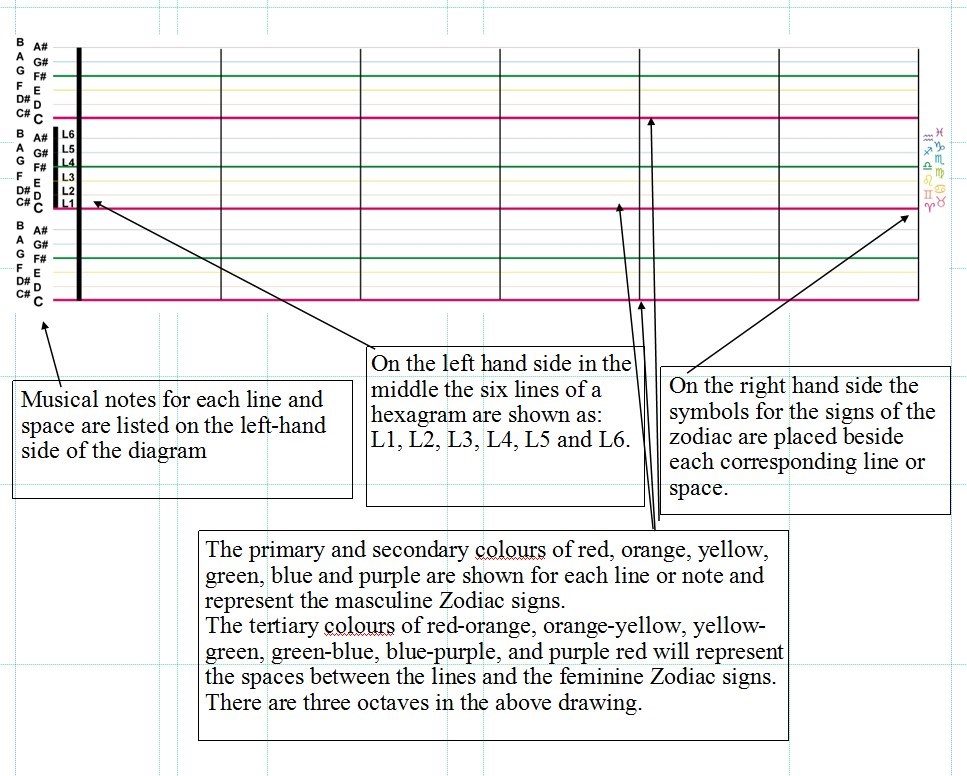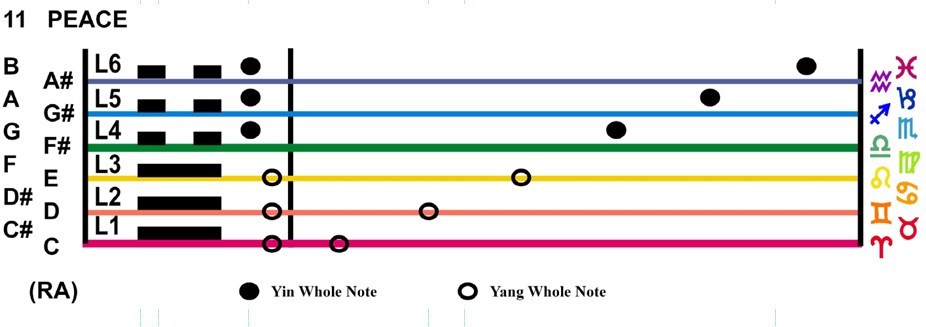Scales 2: Notation: Musical Scales for the I Ching Hexagrams
Click on the image to enlarge and scroll.
The Hexagrams to Musical Scales
Six Line Notation: A chromatic simplicity
A six line bar was adapted to musically record the hexagrams and their changes. It really fit so well. Each note has a specific line or space. There are six lines and six spaces to cover the 12 notes in the chromatic scale.
The normally accepted 5 line bar required some special considerations and more thinking to use. The difficulty with it was that it was not a true scale, in the sense that the divisions were not all equal. This forced a detailed memorization within each scale starting from any note. The distances between lines and spaces were not consistently the same. In comparing to a ruler, it would be impractical to use a ruler that did not use the same length for each inch!
The six line bar, fit so naturally to the 12 note chromatic scale and to the 6 lines of each hexagram that it has been embraced in this appendix.

A further correspondence came into play with the six line notation. It allows a correspondence to each of the signs of the Zodiac and to the 12 colours of the spectrum. This multi-leveled association to several vast systems of thinking stands as an affirmation of its value.
In retrospect, it seems amazing that five bar notation was ever adapted!
The lines of a hexagram count from the bottom up. The Zodiac Signs also start with Aries and move upward to Pisces. The masculine signs correspond to the lines and the feminine lines to the spaces. The colour spectrum too, start with red at the bottom and moves to burgundy at the top. The primary and secondary colours of red, orange, yellow, green, blue and purple each correspond to a line in the music bar. The tertiary colours of red-orange, orange yellow, yellow =-green, green-blue, blue-purple and purple-red correspond to spaces.
Each line of a hexagram relates to two zodiac signs and to two colours. This brings a noteworthy surge of mystic and poetic association to the hexagram lines and the notes and intervals in music.
The result would be similar to the Rosetta Stone which opened the doorway to the understanding of Egyptian hieroglyphics.
That there are 384 seven note scales within a single octave is quite incredible, as is the fact that most western hemisphere music is based on just one of these scales.

Our regular do-re-mi-fa-sol-la-ti scale is one of 384 scales. Interestingly enough, it represents the I Ching hexagram entitle Peace with the third line changing. This specific seven note scale in the hexagram of Peace has been developed more than any of the other scales. With 383 other scales it leaves a lot of room for exploration and future expansion.
The hexagram Peace refers to heaven on earth, or strength within and receptivity without. A thorough reading of Peace in context to western music and its development will provide much food for thought and contemplation.
Music is the study of relationships. Colour is the study of relationships. Astrology is the study of relationships. I Ching is the study of relationships. They are one and the same language under the guise of differences. No doubt the universe is unfolding as it should!
